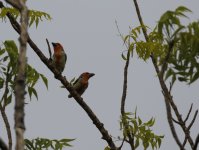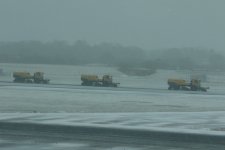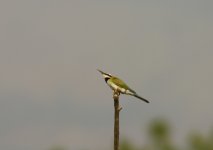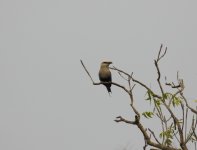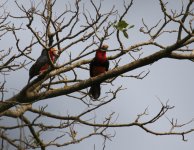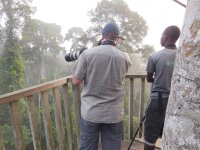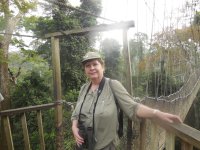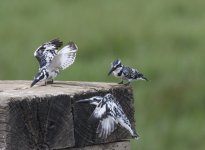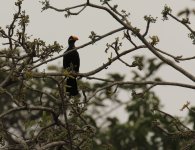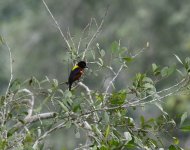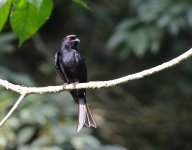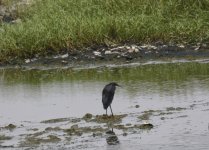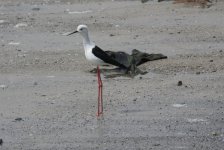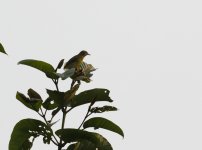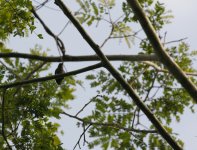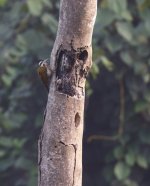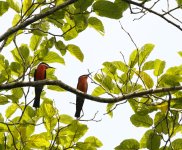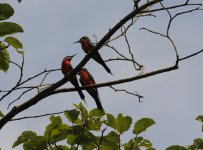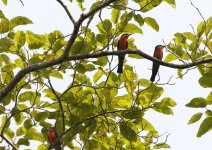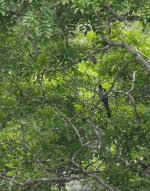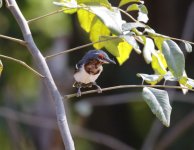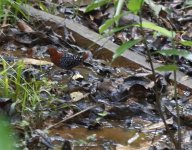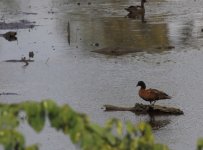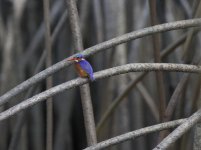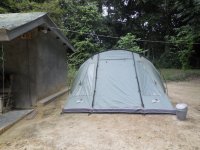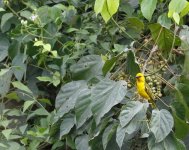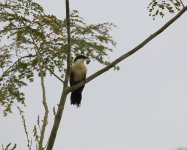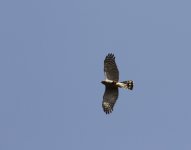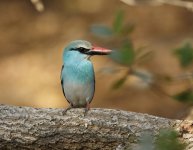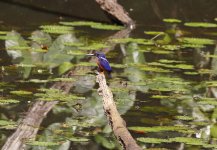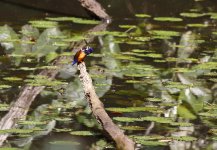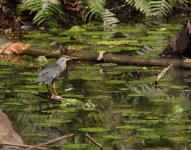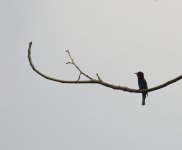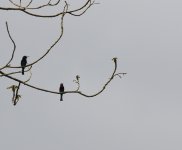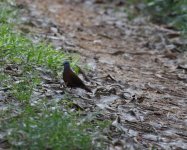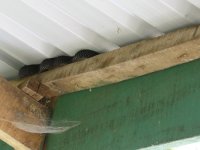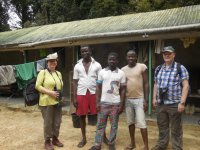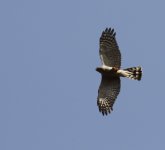Usually when going to Africa we drive ourselves or get a driver and then just get a guide for tricky forest birding but when we were researching Ghana we really wanted to camp in Ankasa and have a safety net on seeing the Picathartes so that pointed towards Ashanti African Tours. As we didn’t want an organised tour; we prefer a very small group as it is much easier to get on birds when just the two of us. Surprisingly a private tour based on the “Birds and Photography itinerary” was not much more expensive than the organised tour and compared very favourably to the 8 night Naturetrek (price only £200 more) that started the day we were leaving and which didn’t do Ankasa, this was based on best available accommodation in the area so it could be done much cheaper. Everywhere we stayed was pretty empty, Ebola seems to have put most people off travelling to West Africa despite the fact that Ghana and all its neighbours have been free of the disease, and so rates and availability is good. So we booked this tour including a 3 night beach extension at Cape Coast, Coconut Grove Resort.
For anyone interested in a break at short notice we notice that Accra airport are now doing Visa on arrival so no need to plan that in.
Another reason Sarah liked Ashanti African Tours was their commitment to conservation and community development initiatives and in particular the Picathartes Education and Conservation for Knowledge Fund. PECK aims to support the 3 communities which surround a small upper guinea rainforest that protects at least 24 nesting sites for this much sought after species. They will assist the communities in educating their children by paying for school and print fees, uniforms, books and supplies. We saw first-hand the start of a school building. Ultimately they hope that by showing commitment to the communities enabling them to see the immediate benefits of conserving the habitat they will help stop the illegal logging and hunting activities by locals that come from or pass through their communities.
Anyway, Day 1 did not get off to the best of starts. We arrived at Manchester Airport at 07.10 for our 8.50 flight to light snow falling. We asked at the check-in desk whether there were any delays but at that stage everything was OK and the 7.55 and 8.50 flights to Heathrow were on time. We were just judged to be too late to get the 7.55 so we went through to the lounge. Where we watched the snow get heavier and snow ploughs began making regular circuits to keep the runway and taxi areas free off snow. The 7.55 got off around 8.30 and our plane landed was in place at gate 141 with a new Departure time off 9.20, there were only about 5 planes ahead of us and 4 off them had loaded their passengers when all noticeboards departure times changed to “more information at 10.00” for all planes. At 10.00 it didn’t look good as those planes with passengers loaded disembarked them, and the board suddenly said more info at 11.00. We found out later the airport was useable but they couldn’t get the de-icing rigs out to clear the snow and ice off the planes (there are only two rigs at Manchester Airport). Our 4 hour transfer time at Heathrow wasn’t looking so generous now. At about 12.00 with the snow finally stopped and with the runway clear we were told that we would be amongst the first planes out about 13.00 – really tight for our connection but just possible. Anyway we were all loaded on the plane before 13.00 when the pilot told us we were number 4 for de-icing and hopefully we would be away soon, 40 minutes later and we were still on the ground with the pilot admitting he didn’t have a clue when they would clear our plane as the rig nearest us only did certain airlines and not BA. Long story short we sat on the plane until 16.00 before they cleared what snow was left from the plane, we knew we had now missed our connections so we emailed and texted the Ashanti Office and our Guide to tell them we would now probably be arriving tomorrow, ironically by this time most of the snow had melted – the plane finally took off around 17.00 and landed just before 18.00 it seemed that pretty much everyone on the plane had missed their connection, in some ways we were quite lucky as we had added an extra night before the tour to go to Shai Hills twice (due to problems with original Air Portugal flight which kept changing due to consolidation of West African flights) and then do the full tour as per the adapted itinerary.
To be fair to BA they handled the re-booking well (we were offered flights via Lagos or Johanesburg the next morning but they were only going to get in a hour or two earlier and were longer flights, so we stuck with getting the next day Accra direct flight and were given vouchers for transport to the local Sheraton Hotel and vouchers for hotel accommodation and meals. There would be no African birds songs tonight or tomorrow morning the only thing on offer was Attenborough’s Birds of Paradise on TV, which just reminded us of our trip to PNG. Only bird we saw was a Pied Wagtail on the trip back to Heathrow.
Fortunately everything went to plan the next day and we arrived on time (24 hours late) in Accra to be met by our guide Victor Owusu and shown to our vehicle a small bus driven by Appiah. The original vehicle had a problem with a wheel and as the organised tour that would have used the bus was cancelled and the next tour wasn’t starting until after we had left that would be our mode of transport for the next two and bit weeks.
Drive to Tema and Alexis Hotel took about 45 minutes but as it was nearly 22.00 there was no time for an evening meal, we just agreed the time for breakfast 5.15 and then leave for the Shai Hills at 5.45. We would come back for an early lunch and to pack. Our first full day with in Ghana, began with an early breakfast that was pretty uniform for the trip Omelette, Toast and some Marmalade with Tea and Coffee.
We then visit the Shai Hills reserve, an expanse of Savannah, grassland and woodland. The bird viewing here is really good we quickly see Common Wattle-eye, Black-shouldered Kite, Double Spurred Francolin, Common Wattle-eye and Western Grey Plantain-eater, a brief view of Stone Partridge but the light is very poor really overcast and initially quite dark. Then we see, Grey Hornbill, Violet and Green turacos, and then the recently split White-crowned Cliff Chat, which displays on a large rock to give good scope views while Rock martins fly overhead. Towards the bat cave also see Northern Puffback, White-throated bee-eaters are everywhere, Blue-bellied and Rufous-crowned rollers are also spotted albeit quite distant. We did see Brown Babblers and Senegal parrots but both were brief slightly obscured views. However the stars of the show were Barbet with Viellot’s, Bearded and Double-toothed all showing in pairs with a Yellow-fronted Tinkerbird calling repeatedly and eventually showing.
We had quite a gentle introduction to Bulbul’s with just Common, Simple and Leaflove to challenge us this morning. It was then back to the hotel for lunch before heading to Sukumona Lagoon and Winneba plain. At the lagoon we saw Black Heron, Western Reef Egret, Collared Pratincol, Curlew Sandpiper, Pied Kingfisher, Sanderling, Marsh Harrier, Greenshank and Marsh Sandpiper. On arrival at Winneba we looked on the burnt field for Lapwings and Coursers but all we spotted were Senegal Thick-knee and Wattled Plover, before a very unexpected Chestnut-bellied Starling flew onto a nearby Tree, Victor was quite excited and said that it shouldn’t be here it is about 3 or 4 hundred miles south of where is should be, so he had me take a few record shots as some of his colleagues at Ashanti doubted the sighting. We then saw a nice Oriole Warbler before crossing the road into another set of fields, where I final spotted a Lesser black-winged Lapwing, once we were all on it, it became clear it was not alone and we soon spotted another 5 birds in the area. It was then time to get moving and we headed for the Rainforest Lodge in near Kakum NP where we would spend the next three nights. Lodge is much better than its description in the Bradt guide to Ghana, they have obviously added some additional rooms and new facilities since the book was written. Food was good and they had a selection of beers to try over the coming nights. Tomorrow it it is off to the Canopy Walkway.
(Bold Red = lifer)
For anyone interested in a break at short notice we notice that Accra airport are now doing Visa on arrival so no need to plan that in.
Another reason Sarah liked Ashanti African Tours was their commitment to conservation and community development initiatives and in particular the Picathartes Education and Conservation for Knowledge Fund. PECK aims to support the 3 communities which surround a small upper guinea rainforest that protects at least 24 nesting sites for this much sought after species. They will assist the communities in educating their children by paying for school and print fees, uniforms, books and supplies. We saw first-hand the start of a school building. Ultimately they hope that by showing commitment to the communities enabling them to see the immediate benefits of conserving the habitat they will help stop the illegal logging and hunting activities by locals that come from or pass through their communities.
Anyway, Day 1 did not get off to the best of starts. We arrived at Manchester Airport at 07.10 for our 8.50 flight to light snow falling. We asked at the check-in desk whether there were any delays but at that stage everything was OK and the 7.55 and 8.50 flights to Heathrow were on time. We were just judged to be too late to get the 7.55 so we went through to the lounge. Where we watched the snow get heavier and snow ploughs began making regular circuits to keep the runway and taxi areas free off snow. The 7.55 got off around 8.30 and our plane landed was in place at gate 141 with a new Departure time off 9.20, there were only about 5 planes ahead of us and 4 off them had loaded their passengers when all noticeboards departure times changed to “more information at 10.00” for all planes. At 10.00 it didn’t look good as those planes with passengers loaded disembarked them, and the board suddenly said more info at 11.00. We found out later the airport was useable but they couldn’t get the de-icing rigs out to clear the snow and ice off the planes (there are only two rigs at Manchester Airport). Our 4 hour transfer time at Heathrow wasn’t looking so generous now. At about 12.00 with the snow finally stopped and with the runway clear we were told that we would be amongst the first planes out about 13.00 – really tight for our connection but just possible. Anyway we were all loaded on the plane before 13.00 when the pilot told us we were number 4 for de-icing and hopefully we would be away soon, 40 minutes later and we were still on the ground with the pilot admitting he didn’t have a clue when they would clear our plane as the rig nearest us only did certain airlines and not BA. Long story short we sat on the plane until 16.00 before they cleared what snow was left from the plane, we knew we had now missed our connections so we emailed and texted the Ashanti Office and our Guide to tell them we would now probably be arriving tomorrow, ironically by this time most of the snow had melted – the plane finally took off around 17.00 and landed just before 18.00 it seemed that pretty much everyone on the plane had missed their connection, in some ways we were quite lucky as we had added an extra night before the tour to go to Shai Hills twice (due to problems with original Air Portugal flight which kept changing due to consolidation of West African flights) and then do the full tour as per the adapted itinerary.
To be fair to BA they handled the re-booking well (we were offered flights via Lagos or Johanesburg the next morning but they were only going to get in a hour or two earlier and were longer flights, so we stuck with getting the next day Accra direct flight and were given vouchers for transport to the local Sheraton Hotel and vouchers for hotel accommodation and meals. There would be no African birds songs tonight or tomorrow morning the only thing on offer was Attenborough’s Birds of Paradise on TV, which just reminded us of our trip to PNG. Only bird we saw was a Pied Wagtail on the trip back to Heathrow.
Fortunately everything went to plan the next day and we arrived on time (24 hours late) in Accra to be met by our guide Victor Owusu and shown to our vehicle a small bus driven by Appiah. The original vehicle had a problem with a wheel and as the organised tour that would have used the bus was cancelled and the next tour wasn’t starting until after we had left that would be our mode of transport for the next two and bit weeks.
Drive to Tema and Alexis Hotel took about 45 minutes but as it was nearly 22.00 there was no time for an evening meal, we just agreed the time for breakfast 5.15 and then leave for the Shai Hills at 5.45. We would come back for an early lunch and to pack. Our first full day with in Ghana, began with an early breakfast that was pretty uniform for the trip Omelette, Toast and some Marmalade with Tea and Coffee.
We then visit the Shai Hills reserve, an expanse of Savannah, grassland and woodland. The bird viewing here is really good we quickly see Common Wattle-eye, Black-shouldered Kite, Double Spurred Francolin, Common Wattle-eye and Western Grey Plantain-eater, a brief view of Stone Partridge but the light is very poor really overcast and initially quite dark. Then we see, Grey Hornbill, Violet and Green turacos, and then the recently split White-crowned Cliff Chat, which displays on a large rock to give good scope views while Rock martins fly overhead. Towards the bat cave also see Northern Puffback, White-throated bee-eaters are everywhere, Blue-bellied and Rufous-crowned rollers are also spotted albeit quite distant. We did see Brown Babblers and Senegal parrots but both were brief slightly obscured views. However the stars of the show were Barbet with Viellot’s, Bearded and Double-toothed all showing in pairs with a Yellow-fronted Tinkerbird calling repeatedly and eventually showing.
We had quite a gentle introduction to Bulbul’s with just Common, Simple and Leaflove to challenge us this morning. It was then back to the hotel for lunch before heading to Sukumona Lagoon and Winneba plain. At the lagoon we saw Black Heron, Western Reef Egret, Collared Pratincol, Curlew Sandpiper, Pied Kingfisher, Sanderling, Marsh Harrier, Greenshank and Marsh Sandpiper. On arrival at Winneba we looked on the burnt field for Lapwings and Coursers but all we spotted were Senegal Thick-knee and Wattled Plover, before a very unexpected Chestnut-bellied Starling flew onto a nearby Tree, Victor was quite excited and said that it shouldn’t be here it is about 3 or 4 hundred miles south of where is should be, so he had me take a few record shots as some of his colleagues at Ashanti doubted the sighting. We then saw a nice Oriole Warbler before crossing the road into another set of fields, where I final spotted a Lesser black-winged Lapwing, once we were all on it, it became clear it was not alone and we soon spotted another 5 birds in the area. It was then time to get moving and we headed for the Rainforest Lodge in near Kakum NP where we would spend the next three nights. Lodge is much better than its description in the Bradt guide to Ghana, they have obviously added some additional rooms and new facilities since the book was written. Food was good and they had a selection of beers to try over the coming nights. Tomorrow it it is off to the Canopy Walkway.
(Bold Red = lifer)




